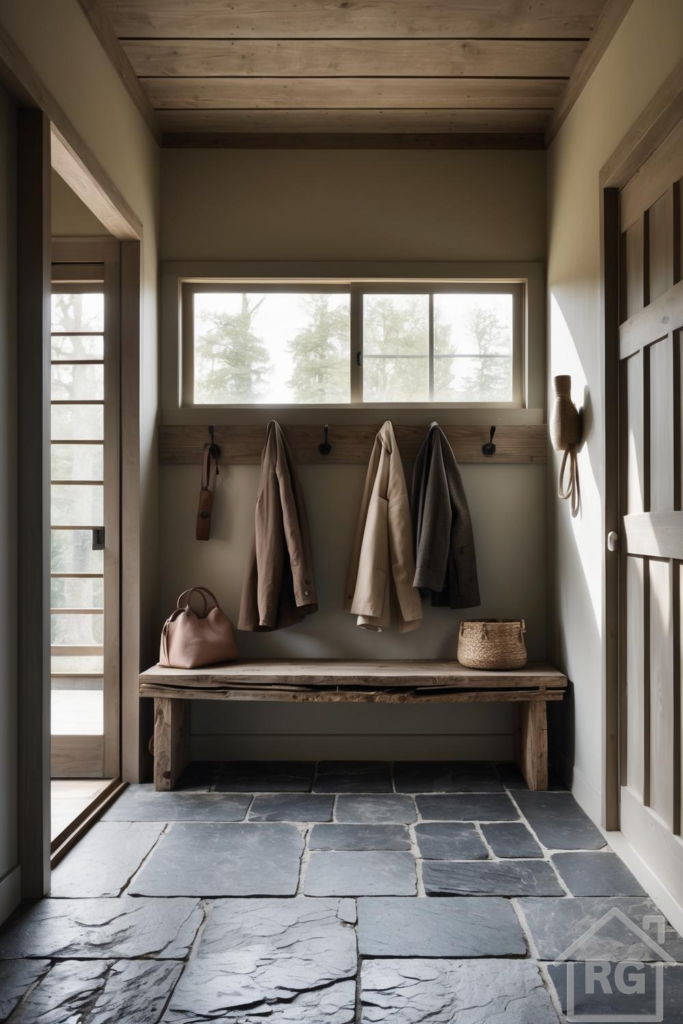
The Essence of Wabi-Sabi in Your Entryway
Step into a realm where beauty lies in imperfection and tranquility reigns supreme. The concept of wabi-sabi, a Japanese philosophy centered on finding beauty within transience and imperfection, offers a profound approach to interior design. Nowhere is this more beautifully exemplified than in a thoughtfully curated mudroom or entryway — the very threshold of your home, a space that welcomes, organizes, and sets the tone for what lies beyond.
Wabi-sabi isn’t just a style; it’s a way of seeing. It celebrates authenticity, the patina of age, and the raw, unrefined beauty of natural materials. For a mudroom or entryway, this translates into a space that feels lived-in, organic, and utterly serene, rather than sterile or overly polished.
Think of the worn texture of an old wooden bench, the subtle variations in natural stone, or the gentle fade of a linen fabric. These elements tell a story, inviting a sense of calm and groundedness from the moment you step inside.
Crafting Your Wabi-Sabi Palette: A Symphony of Neutrals
The color scheme in a wabi-sabi inspired space is inherently natural and subdued, drawing inspiration directly from the earth. In our featured entryway, we see a masterful blend of calming hues that create an immediate sense of peace.
Warm Greige Walls
The walls are painted in a beautiful, warm greige, a sophisticated blend of grey and beige that acts as a perfect neutral canvas. This soft, inviting shade, perhaps akin to a gentle ‘Greige Whisper’ or ‘Stone Hearth,’ allows other elements to shine without overwhelming the senses. It provides a comforting backdrop, reflecting natural light beautifully and making the space feel open and airy.
Rich Natural Wood Tones
Complementing this are the rich, varied tones of natural wood. From the sturdy, reclaimed wooden bench with its visible grain and imperfections, to the lighter, more refined wooden trim and ceiling planks, the wood introduces warmth and organic texture. Imagine the deep, earthy browns of ‘Rustic Oak’ on the bench contrasting with the softer, sun-kissed ‘Pale Birch’ of the ceiling. These wooden elements are not just functional; they are sculptural pieces that ground the design.
Grounding Stone Flooring
Anchoring the entire composition is the striking dark natural stone flooring. The irregular shapes and rough, tactile surface of these slate-like tiles, reminiscent of ‘Charcoal River Stone,’ provide a robust and grounding foundation. This deep, almost black, hue offers a beautiful contrast to the lighter walls and wood, adding depth and a touch of ancient elegance. The interplay between the cool, dark stone and the warm wood creates a dynamic yet harmonious balance.
Subtle Accents & Details
Even smaller details contribute to the palette, such as the soft, blush-toned leather handbag, adding a subtle hint of ‘Rose Clay’ that softens the overall rustic feel, or the natural woven basket, bringing in the golden undertones of ‘Sun-Dried Straw.’ These thoughtful additions complete the serene aesthetic.
The Art of Texture: A Tactile Experience
The most prominent texture comes from the reclaimed wood of the bench and the ceiling. Each knot, grain, and imperfection tells a story, inviting touch and contemplation. This isn’t polished, factory-made wood; it’s wood with character, celebrating its natural state.
The natural stone floor is another tactile marvel. Its uneven surface, subtle ridges, and cool touch underfoot create a sensory experience. This isn’t a smooth, uniform tile; it’s rugged and authentic, connecting the interior to the raw beauty of the outdoors.
Softness is introduced through the linen-like fabrics of the coats hanging on the hooks, offering a gentle contrast to the harder surfaces. The smooth leather of the handbag adds a touch of refined elegance, while the woven natural fiber of the basket brings in a rustic, handcrafted element.
Even the subtle sheen of the metal coat hooks adds a small, functional textural detail, contrasting with the matte finishes of the wood and stone.
Functional Beauty: Designing Your Mudroom for Life
The sturdy wooden bench is central, providing a comfortable spot to sit while putting on or taking off shoes, making daily routines smoother.
Above the bench, the simple yet effective coat rack with metal hooks offers practical storage for outerwear, bags, and accessories, keeping your mudroom organized and clutter-free.
The presence of a woven basket on the bench hints at additional storage for smaller items like gloves, scarves, or even mail, helping to keep clutter at bay while maintaining the natural aesthetic.
The large window is not just a source of natural light but also a visual connection to the outside world, blurring the lines between indoor and outdoor spaces — a key wabi-sabi tenet that promotes calm.
The robust wooden door and its frame echo the natural materials used throughout, creating a cohesive and inviting transition point into your home.
Bringing Wabi-Sabi Home: Tips for Your Entryway Transformation
Embrace Natural Materials: Prioritize wood, stone, linen, cotton, and ceramics. Look for pieces with visible grain, natural imperfections, or a handcrafted feel.
Choose a Soothing Palette: Stick to earthy neutrals — greiges, warm whites, muted greens, and browns. Use darker tones for grounding elements like flooring.
Celebrate Imperfection: Don’t shy away from worn finishes, slight irregularities, or vintage finds. These add character and soul.
Focus on Functionality: Every item should serve a purpose. Keep the space uncluttered, allowing the beauty of individual pieces to stand out.
Incorporate Organic Forms: Look for furniture and decor with soft lines and natural shapes rather than rigid, geometric ones.
Maximize Natural Light: Allow sunlight to flood the space. If natural light is limited, opt for warm, diffused artificial lighting.
Add Subtle Greenery: While not prominent in this image, a small, simple plant can enhance the connection to nature.
Conclusion
A wabi-sabi mudroom or entryway is more than just a functional space; it’s a sanctuary that greets you with calm and authenticity. By embracing natural materials, a soothing color palette, and the beauty of imperfection, you can create a welcoming threshold that truly reflects a mindful and serene way of living. Let your entryway be a testament to the quiet elegance of wabi-sabi, inviting you and your guests to slow down and appreciate the simple, profound beauty of everyday life. Start your transformation today and discover the peace that awaits.
